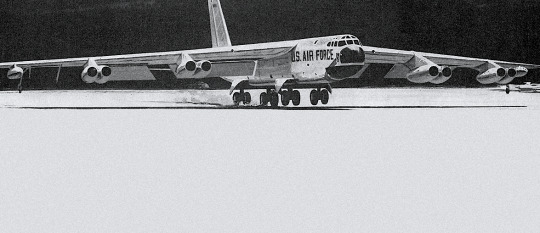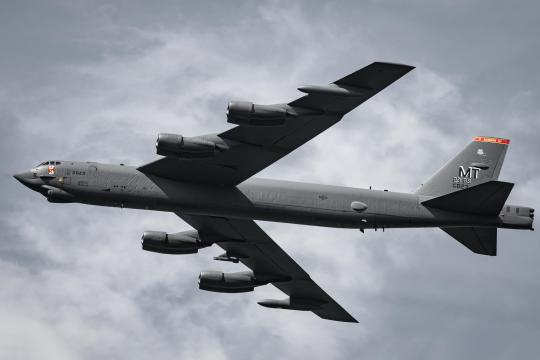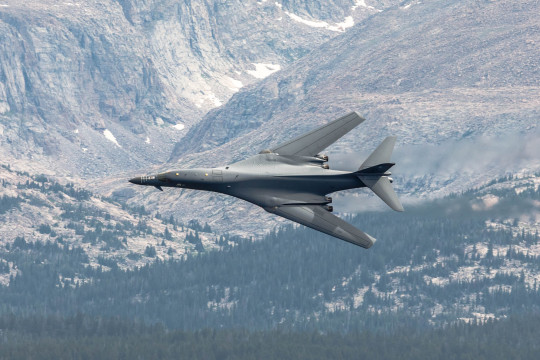#AFGSC
Explore tagged Tumblr posts
Text

The Boeing B-52 Stratofortress.
#vintage illustration#vintage airplane#vintage aircraft#b 52#b-52#boeing b-52 stratofortress#boeing b 52 stratofortress#military aircraft#military aviation#aviation#boeing#bombers#b-52 stratofortress#b 52 stratofortress#military bombers#cold war era#u.s. military#stratofortress#nuclear bombers#jet bombers#usaf#u.s. air force#air force#strategic air command#air force global strike command#afgsc#sac#barksdale afb#strategic bomber
96 notes
·
View notes
Text

The iconic symbol of American Airpower
#Iconic aircraft#Airpower#Boeing#B-52#Stratofortress#Military#bomber#Planes of fame#AFGSC#Air Force#BUFF
286 notes
·
View notes
Text

A USAF E-4B AFGSC (ssgt nicole leidholm)
@kadonkey via X
18 notes
·
View notes
Video
youtube
Aim High, Airmen - AFGSC 15th Anniversary Mission Video
0 notes
Video
200924-F-YH293-1001 by 307th Bomb Wing Public Affairs Via Flickr: A B-1B Lancer’s afterburners glow after taking off from Eielson Air Force Base, Alaska, Sept. 24, 2020. The bomber, assigned to the 345th Expeditionary Bomb Squadron, was on its way to Norway to practice interoperability training with Nordic allies in support of a Bomber Task Force mission. It crossed the Arctic Circle, a region of strategic significance, to help aircrews gain familiarity with the area and ensure it remains a stable and open international environment. (U.S. Air Force photo by Senior Master Sgt. Ted Daigle)
#307th Bomb Wing#345th EBS#345th Expeditionary Bomb Squadron#489th Bomb Group#7th Bomb Wing#AFGSC#AFRC#Air Force Global Strike Command#B-1 Lancer#Bomber#Bomber Task Force#Dyess Air Force Base#U.S. European Command#U.S. Strategic Command#USEUCOM#USSTRATCOM#Eielson Air Force Base#Alaska#United States
12 notes
·
View notes
Text
US AFGSC desactiva el Air Force NC3 Center
US AFGSC desactiva el Air Force NC3 Center
La bandera oficial del Centro NC3 de la USAF se dobla ceremoniosamente durante la ceremonia de desactivación en Barksdale AFB. Crédito: USAF / Aviador Senior Jacob B Wrightsman. El Comando de Ataque Global de la Fuerza Aérea de los EE. UU. (AFGSC) desactivó el Centro de Comando, Control y Comunicaciones Nucleares de la Fuerza Aérea (Centro AF NC3) el 4 de junio. USAF NC3 Center es una…

View On WordPress
0 notes
Text
U.S. Air Force Begins Divestment of 17 B-1B Lancer Bomber Aircraft
#USAirForce begins divestment of 17 B-1B Lancer bomber aircraft. #B1B
The U.S. Air Force (USAF) will begin divesting 17 B-1B Lancer bomber aircraft from its current fleet as authorized by the National Defense Authorization Act, the service announced. According to the Air Force, the divestment is in support of the its efforts to modernize America’s bomber fleet. The 17 B-1B aircraft will be retired from the current fleet of 62 B-1s, leaving 45 in the active fleet.…

View On WordPress
#Rockwell B-1B Lancer#Strategic bomber#U.S. Air Force (USAF)#U.S. Air Force Global Strike Command (AFGSC)#USA
3 notes
·
View notes
Photo

They came today just at the same day I've returned to the city!! @yankasmiles thanks a bunch, they are gorgeous as always <3 can't imagine myself stocking with HQ stickers anywhere else 💓
45 notes
·
View notes
Video
170206-F-LP948-057 by US Air Force Via Flickr: Four B-1B Lancers assigned to the 9th Expeditionary Bomb Squadron, deployed from Dyess Air Force Base, Texas, arrive Feb. 6, 2017, at Andersen AFB, Guam. The 9th EBS is taking over U.S. Pacific Command’s continuous bomber presence operations from the 34th EBS, assigned to Ellsworth AFB, S.D. The B-1B’s speed and superior handling characteristics allow it to seamlessly integrate in mixed force packages. While deployed at Guam the B-1Bs will continue conducting flight operations where international law permit. (U.S. Air Force photo/Tech. Sgt. Richard P. Ebensberger)
#B-1B#Lancer#Continuous Bomber Presence#USPACOM#Andersen Air Force Base#Guam#Bone#CBP#AFGSC#Dyess AFB#Ellsworth AFB#GU#Now Playing#10th#February#2017#February 10th 2017
0 notes
Text

Tiger 41 in the mountains of eastern Wyoming
81 notes
·
View notes
Text

Ellsworth pauses flight operations after B-1 fall; Undeclared fuselage lost
Fernando Valduga By Fernando Valduga 01/11/2024 - 08:47in Aeronautical Accidents, Military
While investigators analyze the wreckage of a B-1 bomber that crashed during the landing at Ellsworth Air Base, South Dakota, on January 4, the runway will remain closed until at least January 19, according to a Notice to Aviators (NOTAM). Ellsworth itself is restricted to visitors "for official business only," the notice said.
A team of investigators, including personnel from the B-1 depot at Tinker Air Base, Oklahoma, is conducting a security investigation to see if there is any immediate mechanical or procedural reason to land the entire B-1 fleet. Although B-1 operations in Ellsworth have been interrupted, operations continue at Dyess Air Base, Texas - the other main B-1 base - and other bombers are available at Edwards Air Base, California, for test operations.
Service officials said it will take at least until January 19 to fully document the accident site and transfer the carcass to a hangar, where further investigation may continue. During this same period, the runway manager will conduct a sweep in the aviation field in search of debris necessary for the investigation and to clean up any potential foreign objects that may threaten future flight operations.

A spokesman for the Global Attack Command said that a chairman of the accident investigation board has been chosen, but the name of this officer has not yet been announced.
The accident investigation board is a longer process that can take many months to find out the root cause or causes of a Class A accident. Class A is any accident that involves loss of life, serious injury, loss of an aircraft or other damage totaling more than $2.5 million. This investigation investigates the actions of the crew, health, rest and training; the history of maintenance of the aircraft; weather conditions; and other important factors.
The weather conditions at the time of the accident were bad, with temperatures below zero and fog in the area. The crashed aircraft was the second in a formation of two B-1s returning from a training flight; the leading aircraft landed without incident.

It has not yet been determined whether the loss was total of the aircraft, according to the spokesman of the Global Attack Command, who could only say that the crashed aircraft "is not in airworthiness conditions".
Unofficial and unconfirmed images circulating on Facebook pages and other social media show a B-1 covered in snow or foam that was severely burned and bent in a catastrophic way in a grassy area next to a track. In an image, the B-1, photographed from behind, is supported by the engines and without the tail cone, with the left deeper very bent. In addition, the wings of the wings projected forward look skeletonized, probably because of the fire.

Another image attributed to a NewsCenter 1 webcam shows the severely damaged aircraft, just ahead of the roots of the wings to the nose.

Satellite images of Ellsworth dated January 6 - taken by Planet Labs and shared with The War Zone - show that the aircraft hit the ground beyond runway 31/13 and, after briefly remaining on the center line, deflected left on the main runway and stopped in the grassy area between the runway and the taxiway, leaving a heavy black trail in its way.
The four crew members were successfully ejected from the aircraft. Three were treated at the base facilities and one in a nearby hospital. Everyone is expected to have a complete recovery.

A broader view of the accident site reveals how the B-1 impacted the ground, continued in the middle of the runway and then deflected to a grassy area. (Photo: 2024 PLANET LABS INC.)
The AFGSC spokesman said it has not yet been determined whether the U.S. Air Force will attempt to replace the crashed aircraft by resurrecting one of the "Boneyard" at Davis-Monthan Air Base, Arizona. This determination may have to wait until the Accident Investigation Board (AIB) makes its final report. The U.S. Air Force is authorized to operate 45 B-1B bombers, but now has only 44.

Apparent marks at the head of the track and around it suggest that the B-1 first impacted the ground here. (Photo: 2024 PLANET LABS INC.)

The remains of the B-1B after the aircraft stopped adjacent to the Ellsworth runway, in satellite images dated January 6, 2024. (Photo: 2024 PLANET LABS INC.)
The USAF persuaded Congress in 2020 to allow the service to reduce the B-1B fleet from 62 to 45 fuselages - but maintain the same level of funding and maintenance personnel - in order to improve the mission capacity levels of the type, which had been facing difficulties. to meet USAF standards after the B-1Bs flew in prolonged service in Afghanistan and Iraq, incurring severe structural fatigue.
The U.S. Air Force justified the divestment by saying, in part, that the B-1s identified for retirement would cost from US$ 10 million to US$ 30 million each to restore full mission capacity.
The last of the 17 B-1s retired in the divestment went to Davis-Monthan in September 2021.

After retirements, the remaining B-1 operating fleet saw an increase in mission capacity rates, with more spare parts and maintenance teams available for each.
It is not clear whether the aircraft sent to Davis-Monthan were placed in recoverable storage - or "inviolable" - or if they were used for cannibalization purposes.
Since 2012, USAF has been performing an extensive structural fatigue test on the wing and fuselage of a B-1B, "aging" the items with pulleys and bars to simulate years of flight. The service reported in 2021 that its goal is to accumulate 28,000 hours of simulated flight on the wing and 27,000 hours on the fuselage, but at that time it was late and had only "aged" the two test articles for about 16,000 hours on the wing and 7,200 hours on the fuselage. The tests are also interrupted from time to time to make changes and modifications to the test articles, so that they are representative of operational aircraft, which occasionally have reinforcements or other structural improvements applied.
In 2021, the B-1 fleet had an average of about 12,000 hours of flight time.
Source: Air & Space Forces Magazine
Tags: Aeronautical AccidentsMilitary AviationB-1B LancerUSAF - United States Air Force / U.S. Air Force
Sharing
tweet
Fernando Valduga
Fernando Valduga
Aviation photographer and pilot since 1992, he has participated in several events and air operations, such as Cruzex, AirVenture, Dayton Airshow and FIDAE. He has works published in specialized aviation magazines in Brazil and abroad. He uses Canon equipment during his photographic work in the world of aviation.
Related news
KC-390 aircraft in flight refueling configuration flies in formation with four F-39 Gripen fighters during command passage in Brasilia. (Photo: 2º Sgt Carla Fioroni via Saab Brazil)
BRAZILIAN AIR FORCE
IMAGES: COMPREP presents new Commander in ceremony that featured flight of KC-390 and four Gripens
10/01/2024 - 20:38
MILITARY
Russia wants to build new aircraft carrier as the Russian Navy expands capabilities
10/01/2024 - 20:16
ARMAMENTS
Germany approves sale of IRIS-T air-to-air missiles to Saudi Arabia
10/01/2024 - 19:39
MILITARY
IMAGES: Lockheed Martin delivers the first two F-16 Block 70 to Slovakia
10/01/2024 - 19:20
MILITARY
L3Harris will provide advanced sensors for Canadian drones MQ-9B SkyGuardian
10/01/2024 - 14:00
AERONAUTICAL ACCIDENTS
iPhone is found intact after falling from Alaska Airlines' 737 MAX aircraft
10/01/2024 - 11:00
3 notes
·
View notes
Video
150713-F-ZZ999-904.jpg by US Air Force Via Flickr: The Sodium Guidestar at the Air Force Research Laboratory Directed Energy Directorate's Starfire Optical Range. Researchers with AFRL use the Guidestar laser for real-time, high-fidelity tracking and imaging of satellites too faint for conventional adaptive optical imaging systems. The range’s world-class adaptive optics telescope is the second largest telescope in the Defense Department. (Courtesy photo)
#2015 AF Year in Photos#Airforce#air#afphotos#bestafphotos#acc#aetc#afgsc#afmc#afrc#afsc#afsoc#usafcc#amc#ang#pacaf#usafeafa#iraq#afghanistan#379airexpeditionarywing#380thairexpeditionarywing#438thairexpeditionarywing#451stairexpeditionarygroup#455thairexpeditionarywing
0 notes
Link
0 notes
Video
North Pole mission by 307th Bomb Wing Public Affairs Via Flickr: A B-1B Lancer assigned to the 345th Expeditionary Bomb Squadron flies over the Arctice Circle, Sept. 25, 2020. Two bombers assigned to the unit completed flights that passed directly over the North Pole enroute to perform interoperability training with the Norwegian air force. (U.S. Air Force aircrew photo)
#307th Bomb Wing#345th EBS#345th Expeditionary Bomb Squadron#489th Bomb Group#7th Bomb Wing#AFGSC#AFRC#Air Force Global Strike Command#B-1 Lancer#Bomber#Bomber Task Force#Dyess Air Force Base#U.S. European Command#U.S. Strategic Command#USEUCOM#USSTRATCOM#Eielson Air Force Base#Alaska#United States
10 notes
·
View notes
Text

@sundownridge thank you for the inquiry! I've answered what I could. The headcanon I would truly love to share in relation to Alfred's pilot activities in World War II I don't have the confidence to put out into the world. At least not right now.
But gonna be real, I think tired me was far too confident in posting this drawing!! But now you're asking me to talk about my special interest. There is far too much under the cut. You have been warned.
So, gonna make a disclaimer. I made choices regarding his jacket based on old photos of my great-grandfather and his crew, his plane, and other assorted texts and photos he kept/received from his flight buddies. 2 AM me was not about to fabricate WWII USAAF organization, so my hand was informed by pre-existing knowledge. Just spent a couple hours digging through my great-grandfather's records and things he collected for some of this. And checking my dragon's hoard of sources and PDFs and notes.

We'll start with the Eighth Air Force patch on Mr. Jones' shoulder here :D First off, The Eighth Air Force is a numbered air force (NAF) of the AFGSC and is still around today, but it was established on February 22, 1944, after the redesignation of the VIII Bomber Command. This command was one of the USAAF combat air forces in the European Theatre of WWII, engaged mainly in Northern Europe, whose detachment in England was based out of RAF Daws Hills. The "Mighty Eighth" was the first strategic air force that the United States would activate (activated January 28, 1942). The Mighty 8th is made up of Bombardment Groups, Fighter Groups, and Reconnaissance Groups, to name a few of the operations a NAF runs - all of these encompassed by Bomb or Fighter 'Wings'. I'll just go down the hierarchy that I've slotted Alfred into:
-- -- -- -- --
4th Combat Bombardment Wing (Heavy) - Division Symbol: Square.
I cannot find a picture of the proper insigne, but going a step down from the Eighth Air Force brings us to the 4th Bombardment Wing. Constituted October 19, 1940, then activated (as we know it) June 7, 1942, the 4th Wing was moved to England sometime in Aug-Sep 1942, being then assigned to the 8th AAF. It went unmanned until January 1943, having groups assigned to it and beginning combat operations in May with its first attack on an aircraft factory at Regensburg - at which point it was redesignated the 4th Combat Bombardment Wing (Heavy). This Heavy (H) designation denotes the classification of aircraft flown by the Wing, which was the "heavy" bombers, the Boeing B-17 and Consolidated B-24. Because of reorganization in September 1943, the 4th Wing becomes part of the 3rd Bomb Division. This is confusing to explain - so accept my words with a grain of salt.
But now we know what type of aircraft that OP believes Alfred would have been flying. Either the B-17 or B-24. Personally I go with the B-17.
-- -- -- -- --

The 94th Bombardment Group (Heavy) was originally trained for overseas operations flying the B-17 Flying Fortress, flying with the motto: "Cunning-Rugged-Courageous."* Group Letter: Insignia Blue 'A' (over a White Square). Identifiers: Entire tail & horizontal stabilizers of aircraft painted yellow & a red tail band + red chevron on the wings (sources murky on the latter).
Encompassing the 331st, 332nd, 333rd, and 410th Bombardment Squadrons, the 94th Bomb Group operated out of Rougham Airfield at Bury St. Edmunds, England. This was chiefly a strategic bombing group that focused on targeting infrastructure. Flying their first mission on June 13, 1943, they bombed an airdrome at St. Omer, but otherwise aimed for ports, factories, and shipyards. ((OP has a chronophotographic sequence of a mickey run on a ball bearing factory in Kassel, shot from B-17G #42-10935 "The Gremlin's Hotel".)) The 94th Bomb Group would participate in significant operations such as Big Week, D-Day, and the Battle of the Bulge, among other things. After V-E Day, the 94th was assigned to airlifts over Germany, after which it would be returned to the United States and deactivated-reactivated more than once and in several different forms before becoming the 94th Operations Group. Flying C-130s, the 94th OG continues to serve in the modern day.
*Rarely cited with the motto "Cunning-Rugged-Outrageous" or "Results Count".
-- -- -- -- --
Finally, we get to the squadrons. But I would like to dispel some misconceptions on aircraft and pilots. The common belief is that one pilot/crew is assigned to a single aircraft - this is not the case. An aircraft might have a pilot's name on the canopy rail or fuselage, but this does not mean the pilot will always fly that plane. To use my own Grampa as an example, while we know that he was often the pilot of #42-102935 "The Gremlin's Hotel" (denoted as "935" on papers), we have several records of him flying other aircraft, such as #42-102456 "Shady Lady" and others. This can make tracking individual servicemen and aircraft difficult when your expectation is that one pilot flies only one plane.
And service members may be moved around due to vacancies or the needs of the greater organization. At some point, Grampa was transferred from the 331st to the 333rd, though we don't know why. We have pictures of him in his jacket, which bears the insigne of the 331st BS, but we have images of him and his crew where the rest of the men are wearing the insigne of the 333rd BS. They must have lost their pilot and needed a replacement. It was this example that I used as reasoning for giving Alfred two different squadron patches. Again, I colored those at approximately 2:00 in the morning, so I think I was on autopilot - excuse my pun - and gave him these very patches because I wasn't about to go down the rabbit hole to find others. These patches are what I know off the top of my head at any given moment.

Emblem of the 331st Bombardment Squadron - theatre-made. Squadron Code: 'QE'. Squadron Identifiers: Blue engine cowlings.

Emblem of the 333rd Bombardment Squadron. Squadron Code: 'TS'. Squadron Identifiers: Green engine cowlings.
I have to admit that there is not much individual history available on either of these. I have spent a lot of time searching, however, some of the records are either lost or not publicly available. I admit that I haven't been doing as much research as I used to, but I have a list of people I've been meaning to contact on both of these squadrons. Someday I would like to research the 332nd & 410th Squadrons as well, since they were as much a part of the 94th as the squads I know.

[wip] we do a little bit of drawing
#hetalia#historical hetalia#aph america#hws america#alfred f jones#alfred f jones // daring to fly#alfred's bomber#gremlin military history#military history#world war ii#world war 2#wwii#ww2#eighth air force#b 17#b 17 flying fortress#i think about bombers too much#i am also way too afraid to share my 'alfred's bomber' headcanon#i want to in a way so bad that y'all don't understand#but the public perception terrifies me#also sorry for once again posting non-hetalia things to my hetalia blog#i hope you guys enjoy this anyways#this was really fun to write#i don't expect anyone to be interested#there's so much in this post i could also go in-depth on it's not even funny#like omg#bomber tactical markings!!#i love bomber tactical markings so much#ah well#i'm rambling in the tags
260 notes
·
View notes
Text
AFGSC Test-launches Unarmed Minuteman III ICBM
#USAirForce Global Strike Command (#AFGSC) test-launches unarmed Minuteman III intercontinental ballistic missile (#ICBM) equipped with a test reentry vehicle.
A team of U.S. Air Force Global Strike Command (AFGSC) Airmen launched an unarmed Minuteman III intercontinental ballistic missile (ICBM) equipped with a test reentry vehicle at 11:47 p.m. Pacific Time Feb. 24 from Vandenberg Air Force Base, California. During this test, the ICBM’s reentry vehicle traveled approximately 4,200 miles to the Kwajalein Atoll in the Marshall Islands. These test…

View On WordPress
0 notes

